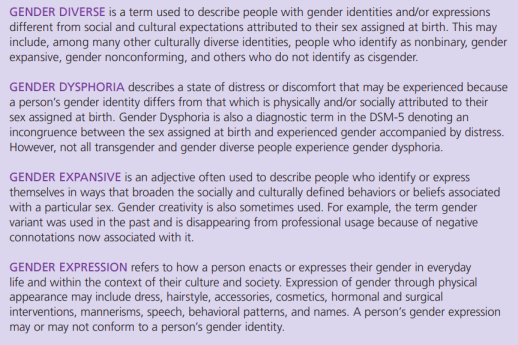What does it mean to be a transgender person?
Transgender people are individuals of any age whose gender identity and expression does not conform to norms and expectations traditionally associated with their sex assigned at birth. In contemporary usage, ‘transgender’ or ‘trans’ has become an umbrella term that is used to describe a wide range of identities and experiences. Other words include gender diverse, sometimes used for people who do not identify as transgender or trans but have a gender identity different from that assigned at birth. Not all transgender people want to undergo gender-affirming medical interventions such as GAHT and gender-affirming surgery (GAS).
What are the current medical views on transgender identities?
Gender identity is usually considered to be established in the early preschool years. For some people, their recognition as being different from their assigned gender can happen during childhood itself. For others, this recognition may arise during adolescence or adulthood.
The understanding of gender identity development is evolving and has been complicated by the politicalization of transgender healthcare and transgender lives (e.g., sports, bathrooms). The World Professional Association for Transgender Health (WPATH) specifically notes that “the expression of gender characteristics, including identities, which are not stereotypically associated with one’s assigned sex at birth, is a common and culturally diverse human phenomenon [that] should not be judged as inherently pathological or negative.”
This changing understanding of gender identity is reflected in the changing nomenclature of diagnosis systems. In the fifth edition of the ‘Diagnostic and Statistical Manual of Mental Disorders (DSM‑V-TR), ‘gender identity disorder’ is replaced by the term ‘gender dysphoria.’ ‘Gender dysphoria’ refers to the discomfort or distress caused by a discrepancy between someone’s gender identity and that person’s sex assigned at birth (and their associated gender role and/or primary and secondary sex characteristics).
WPATH stresses that only some transgender people experience gender dysphoria at some point. In the 10th edition (1994) of the International Classification of Diseases (ICD‑10) of the World Health Organization (WHO), the category ‘gender identity disorder’ still exists. However, the WHO removed many terms related to gender identity, including ‘gender identity disorder’ in ICD 11 (2022). In addition, ‘gender incongruence,’ was added under Conditions Related to Sexual Health. Gender incongruence is a marked and persistent incongruence between the gender felt or experienced and the gender assigned at birth.

Trans & Proud: Being Transgender in the Cook Islands:
“I want to be a girl,” Talia once said to her mom. She also decided to write a letter to her dad. Although Talia was initially worried about her father’s response about her desire to transition, Talia’s father assured her of his unconditional love.
Read the story of Talia here!
when
Subject
LGBTI+

Glossary of terms
IMAP Statement on Hormone Therapy for Transgender and Gender Diverse Persons
Glossary of terms
IMAP Statement on Hormone Therapy for Transgender and Gender Diverse Persons
Glossary of terms
IMAP Statement on Hormone Therapy for Transgender and Gender Diverse Persons
Glossary of terms
IMAP Statement on Hormone Therapy for Transgender and Gender Diverse Persons
Glossary of terms
IMAP Statement on Hormone Therapy for Transgender and Gender Diverse Persons








